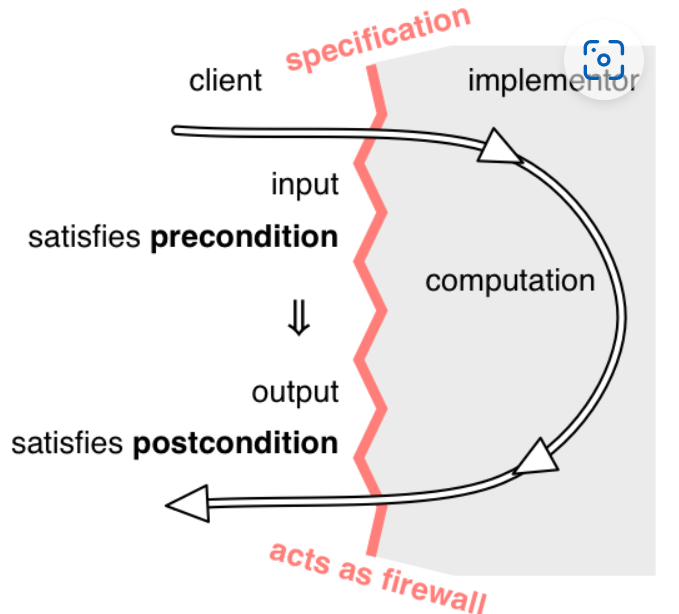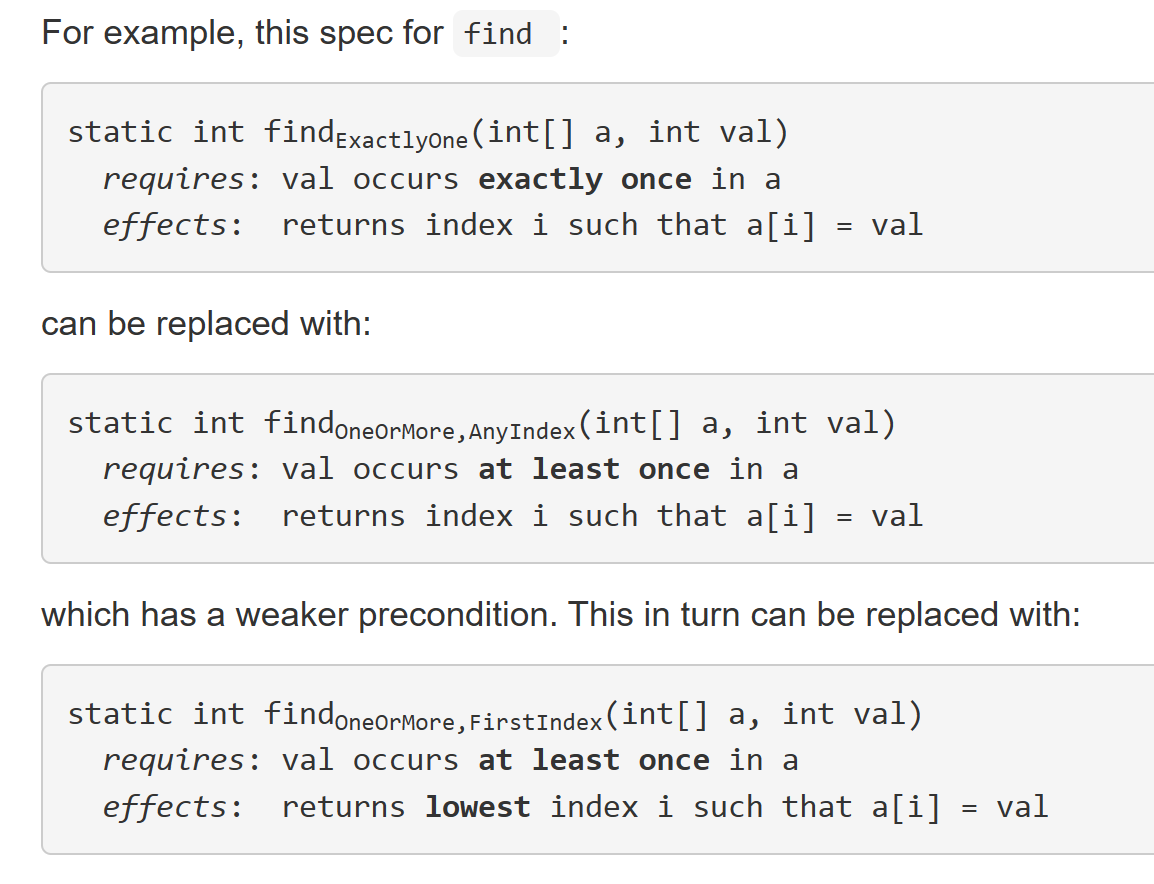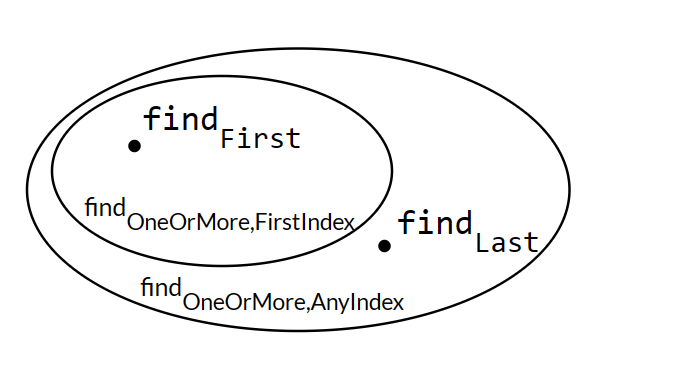文档
规格说明 specification¶

- 客户不再需要通过阅读复杂代码了解功能,实现者也可以更加自由的编写代码;
- 规格说明的格式
/** * Get the next element of the list. * Requires: hasNext() returns true. * Modifies: this iterator to advance it to the element * following the returned element. * @param list list to iterate over * @return next element of the list * @throws NoSuchUserException if nobody with username is in MIT's database */
规格说明的内容¶
- 前置条件 precondition
- 在调用方法前需要成立的条件,比如输入参数的要求
- 后置条件 postcondition
- 方法执行之后将会成立的条件,给出对期望结果的保证,不如对返回值的保证
-
如果调用方法时前提条件成立,那么方法完成时后置条件也必须成立。
-
避免使用 null,通常应该禁止 null 参数或 null 返回值,如果需要使用 null 应该在说明中明确指出
-
默认不会对输入的参数进行修改(函数的副作用),如果需要更改,应该明确指出
-
不需要包含内部变量、实现等内部自身的内容
-
/** * Find a value in an array. * @param arr array to search, requires that val occurs exactly once * in arr * @param val value to search for * @return index i such that arr[i] = val */ static int find(int[] arr, int val)
static int find(int[] arr, int val)
requires: val occurs in arr
effects: returns index i such that arr[i] = val
int[] array = new int[] { 7, 7, 7 };
assertEquals(0, find(array, 7)); // bad test case: violates the spec
assertEquals(7, array[find(array, 7)]); // correct
^f74bca - 并没有说明有多个匹配时的返回规则,不能自己进行假定,测试要按照规则严格制定 - 同时,先决条件说了一定在 arr 中出现 val,因此也不需要测试不存在的情况
规格说明的性质¶
- 决定性(Deterministic):规范是否仅为给定输入定义了唯一的可能输出,或者允许实现者从一组合法的输出中进行选择?
- 如果规范是高度决定性的,那么对于相同的输入,它将有一致的、唯一的输出。
- 如果规范具有一定的非决定性(underdetermined),那么对于相同的输入,可能有多个合法的输出。(并不是说每次输入,结果会发生变化,就像使用了随机数,而只是说不能通过输入预判一个确定的结果,有多个结果都可以作为合法的输出,这取决于具体的实现)
-
比如对于在数组中查找元素
//只出现一次,返回值确定,为决定性的 static int findExactlyOne(int[] arr, int val) requires: val occurs exactly once in arr effects: returns index i such that arr[i] = val //多次出现,返回值不确定(比如从前向后和从后向前搜索就会得到不同的结果),为非决定性 static int findOneOrMore,AnyIndex(int[] arr, int val) requires: val occurs in arr effects: returns index i such that arr[i] = val -
声明性(Declarative):规范是仅描述输出应该是什么,还是明确说明了如何计算输出?
- 声明性规范通常更加抽象,只关注所需的结果,而不涉及实现的细节。
- 明确性 (operational) 规范则提供了实现的详细步骤,以确保结果的生成。(如 pseudocode 伪代码,通常不使用这种类型,因为这会对外暴露内部实现,导致客户使用不想被使用的具体实现细节)
-
在大部分情况下,不应该在函数的规范说明处解释函数的具体实现细节。这部分注释应该在具体的代码中作为行中的注释
-
强度(Strength):规范是否对合法的实现有明确的限制,还是具有广泛的合法实现方式?
- 强规范可能会规定只有一小部分合法实现方式,通常用于对特定问题的严格约束。
- 弱规范则可能会允许更多不同的实现方式,通常用于更灵活的问题。
-
如何修改方法而不应先原先用户的使用:S2 的规范应该强于修改之前的 S1
- S2 的前置条件不强于 S1
- S2 的后置条件不弱于 S1

-
图表示
- 圆圈表示规范,内部表示具体实现,圈越小说明条件越强

什么是好的规格说明¶
- coherent:连贯一致的,每个说明(函数)应该专注于完成一个任务
/** * Update longestWord to be the longest element of words, and print * the number of elements with length > LONG_WORD_LENGTH to the console. * @param words list to search for long words */ public static void countLongWords(List<String> words) -
应该考虑把找到最长的单词和筛选划分为两个独立的方法
-
提供足够的(明确的)信息
- 如返回值 null 表示表示特殊含义,则就应该表示唯一的特殊含义而不应该具有歧义
-
足够强,为用户提供足够的必要保证
static V put (Map<K,V> map, K key, V val) requires: val may be null, and map may contain null values effects: inserts (key, val) into the mapping, overriding any existing mapping for key, and returns old value for key, unless none, in which case it returns null -
虽然提到遇到 null 会抛出异常,但是用户不知道已经有哪些元素加入了 list,也就是说用户不知道如何对异常进行处理
-
足够弱
static File open(String filename) effects: opens a file named filename -
保证打开文件是不现实的,应该是尝试打开文件等
-
尽可能使用抽象数据结构(如 List 接口),提供更大的自由度
- 如使用 List 而不是 Arraylist 减少不必要的转换(如果 ArrayList 的特性并不是必须的)
-
有时应该对输入进行检查(由方法判断前置条件是否得到满足,尽早抛出异常);而有时应该由调用者自行检查(如二分搜索)。具体何时进行检查由检查的代价,以及应用范围决定。